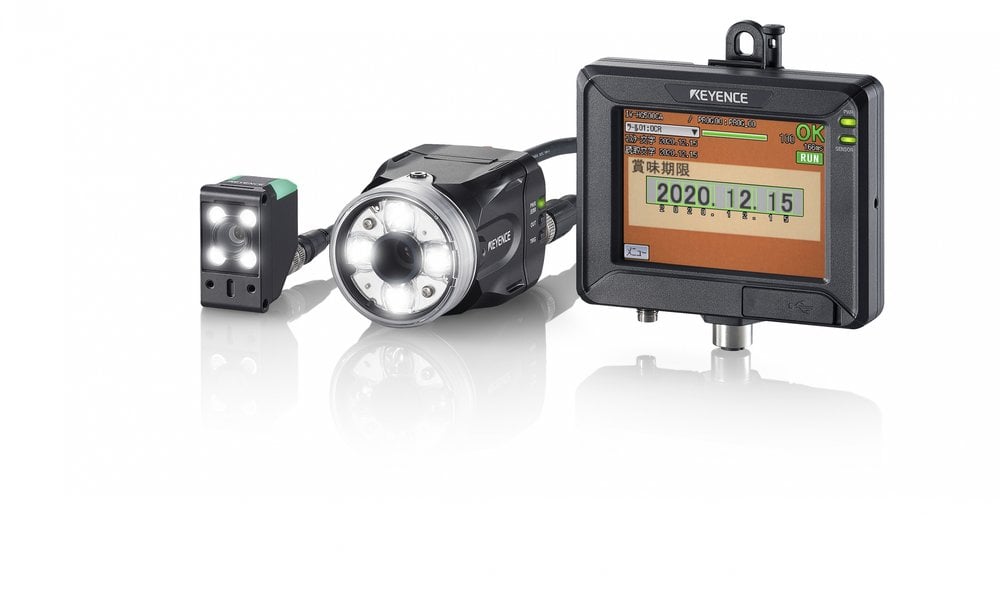www.magazine-industry-usa.com
04
'18
Written on Modified on
Much easier set
up and more stable detection: KEYENCE ultra-compact Vision Sensor IV Series now features OCR

KEYENCE updated its Vision Sensor IV Series with optical character recognition (OCR) capability that can offer a simple, three-step (1 minute) set-up routine and more stable detection through high-intensity illumination and high-performance lens technology. In addition, the ultra-compact size makes the vision sensors easy to retrofit for companies updating their equipment. Automotive, food, cosmetics, pharmaceutical and electronics manufacturing plants are among those set to benefit from the streamlined and simplified detection of various product features. This continues the company’s trend of bringing inspection tools to market that deliver genuine advantages for customers.
Amid the major technology advances of the Vision Sensor IV Series is the new OCR tool that detects whether the text/date on the target being inspected matches the text/date information on the registered master image. Importantly, there is no need to perform extraction (adjusting character width and height), register a dictionary, or any other setting configurations required with conventional vision sensors. Users simply outline the text to identify it. Furthermore, stable reading is possible regardless of changes to the text’s shading, contrast, thickness or size – production engineers do not have to reteach the system. A wide variety of marking formats are supported, including, inkjet printers, laser markers and thermal printers.
Process stability is vital to successful OCR. A common issue with conventional vision sensors is that they often fail to capture clear images, while erroneous detections can frequently occur due to sensor misalignment. In contrast, the stability of the Vision Sensor IV Series facilitates accurate detection without variation, supported by the capture of high-quality, clear images that are unaffected by changes to ambient light conditions. Also, entire surfaces are checked, providing high protection against misaligned targets.
High-intensity Hi-R illumination is key to the advanced performance of the new vision sensors. Here, KEYENCE has researched different reflector shapes that help to minimise the loss of light intensity from the LEDs. The result is uniform and overwhelmingly bright lighting across the entire field of view.
An additionally important feature of the sensors is the newly developed high-performance HP-Quad lens, which contains four layers of glass. This design serves to minimise the effect of lens distortion, making it possible to capture bright, clear images with low distortion.
To support stable detection it is necessary to capture a large image of the target. Here, 10 different types of available sensor head in the Vision Sensor IV Series means that a wide variety of target sizes and detecting distances can be supported. What’s more, the digital zoom function can be used to capture a large image of the target when it is not possible to bring the sensor close due to the presence of obstacles or the product design.
With conventional vision sensors, specialised knowledge is often required in order to choose and install them. In short, a certain amount of time is needed for users to become familiar with the technology. The KEYENCE Vision Sensor IV Series overcomes these difficulties with its inherent ease-of-use that makes it possible for anyone to operate the sensor and, if required, easily perform 100% inspection routines.
Simple installation is another major benefit. With a product envelope of just 44.3 x 31 x 24 mm (smallest in class), the sensors can be installed anywhere, even in systems where there is minimal space availability. Furthermore, the cable connector can be rotated by up to 330° to suit any space restrictions, ensuring a high degree of freedom when it comes to installations.
Further capabilities of the Vision Sensor IV Series include automatic brightness adjustment at the push of a button and best-in-class, high-speed, high-accuracy automatic focus.
The IV Series can be set up with an intelligent monitor (IV-M30) or a PC. As PCs can have a larger display, set-up procedures are even easier to understand and can be quickly configured by first-time users. Additionally, a simulation function allows users to check and modify the program configurations, and perform operation simulations based on image history without connecting the sensor. This functionality enables easy computation of the optimal thresholds while looking at the detection result statistics and histogram, even when away from the workplace.

